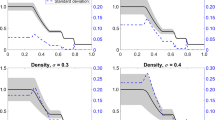Abstract
The numerical-stability consequences of the remaining ellipticity in the Parabolic Stability Equations (PSE) are studied. The analysis of Li and Malik of the constant-coefficient Navier-Stokes equations is extended by a detailed analysis of the parabolizing steps. Dropping of the highest streamwise derivative removes the slowest decaying upstream propagating mode, whereas the fastest remains. This mode can be numerically damped, by use of an implicit discretization of the streamwise derivative and a large enough streamwise step size. Suggestions of how to make the equations well-posed by the addition of a term proportional to the truncation error of the implicit scheme are given. This term is easy to implement, does not change the order of approximation and removes the step-size restriction. An explicit formula for the critical step size is also derived, in the modified equations, which shows that the equations are completely stabilized for a properly chosen stabilization parameter.
Similar content being viewed by others
References
M. Gaster, On the effects of boundary-layer growth on flow stability. J. Fluid Mech.66 (1974) 465-480.
W. S. Saric and A. H. Nayfeh, Non-parallel stability of boundary-layer flows. Phys. Fluids18 (1975) 945-950.
S. A. Gaponov, The influence of flow non-parallelism on disturbance development in the supersonic boundary layers. In: Proc. 8th Canadian Congr. of Appl. Mech. (1981) pp. 673-674.
N. M. El-Hady, Nonparallel instability of supersonic and hypersonic boundary layers. Phys. Fluids A3 (1991) 2164-2178.
P. Hall, The linear development of Görtler vortices in growing boundary layers. J. Fluid Mech. 130 (1983) 41-58.
N. Itoh, The origin and subsequent development in space of Tollmien-Schlichting waves in a boundary layer. Fluid Dyn. Res.1 (1986) 119-130.
Th. Herbert and F. P. Bertolotti, Stability analysis of nonparallel boundary layers. Bull. Am. Phys. Soc. 32 (1987) 2079.
Th. Herbert, Boundary-layer transition - analysis and prediction revisited. AIAAPaper 91-0737 (1991).
F. P. Bertolotti, Linear and Nonlinear Stability of Boundary Layers with Streamwise Varying Properties.Ph.D. Thesis. The Ohio State University (1991) 189 pp.
F. P. Bertolotti, Th. Herbert and S. P. Spalart, Linear and nonlinear stability of the Blasius boundary layer. J. Fluid Mech. 242 (1992) 441-474.
M. Simen, Local and nonlocal stability theory of spatially varying flows. In: M. Y. Hussaini, A. Kumar and C. L. Streett (eds), Instability, Transition and Turbulence, New York: Springer-Verlag (1992) pp. 181-201.
M. Simen, Lokale und nichtlokale Instabilität hypersonischer Grenzschichtströmungen.Ph.D. Thesis. DLR FB 93–31 (1993) 200 pp.
S. G. Rubin, A Review of marching procedures for parabolized Navier-Stokes equations. In: T. Cebeci (ed.), Proc. Symp. Num. and Phys. Aspects Aerodyn. Flows. New York: Springer-Verlag (1981) pp. 171-186.
S. G. Rubin and J. C. Tannehill, Parabolized/reduced Navier-Stokes computational techniques. Ann. Rev. Fluid Mech.24 (1992) 117-144.
D. A. Anderson, J. C. Tannehill and R. H. Pletcher, Computational Fluid Mechanics and Heat Transfer. New York: Hemisphere (1984) 599 pp.
S. C. Lubard and W. S. Helliwell, Calculation of the flow on a cone at high angle of attack. AIAA J. 12 (1974) 965-974.
Y. C. Vigneron, J. V. Rakish and J. C. Tannehill, Calculation of supersonic viscous flow over delta wings with sharp subsonic leading edges. AIAAPaper 78–1137 (1978).
Y. C. Vigneron, J. V. Rakish and J. C. Tannehill, Calculation of supersonic viscous flow over delta wings with sharp subsonic leading edges. NASA TM-78500 (1978).
T. C. Lin and S. G. Rubin, A numerical model for supersonic viscous flow over a slender reentry vehicle. AIAAPaper 79–0205 (1979).
S. G. Rubin and A. Lin, Marching with the parabolized Navier-Stokes equations. Isr. J. Technol. 18 (1980) 21-31.
M. Israeli and A. Lin, Iterative numerical solutions and boundary conditions for the parabolized Navier-Stokes equations. Comput. Fluids13 (1985) 397-409.
H. Haj-Hariri, Characteristics analysis of the parabolized stability equations. Stud. Appl. Math. 92 (1994) 41-53.
F. Li and M. R. Malik, Mathematical nature of parabolized stability equations. In: R. Kobayashi (ed.), Laminar-Turbulent Transition. Proc. 4th IUTAM Symposium Sendai/Japan 1994. Berlin: Springer-Verlag (1995) pp. 205-212.
F. Li and M. R. Malik, On the nature of PSE approximation. Theor. Comp. Fluid Dyn.8 (1996) 253-273.
H.-O. Kreiss and J. Lorenz, Initial-Boundary Value Problems and the Navier-Stokes Equations. New-York: Academic Press (1989) 402 pp.
A. Nayfeh, Perturbation Methods. New-York: John Wiley & Sons (1973) 425 pp.
Author information
Authors and Affiliations
Rights and permissions
About this article
Cite this article
Andersson, P., Henningson, D. & Hanifi, A. On a Stabilization Procedure for the Parabolic Stability Equations. Journal of Engineering Mathematics 33, 311–332 (1998). https://doi.org/10.1023/A:1004367704897
Issue Date:
DOI: https://doi.org/10.1023/A:1004367704897



